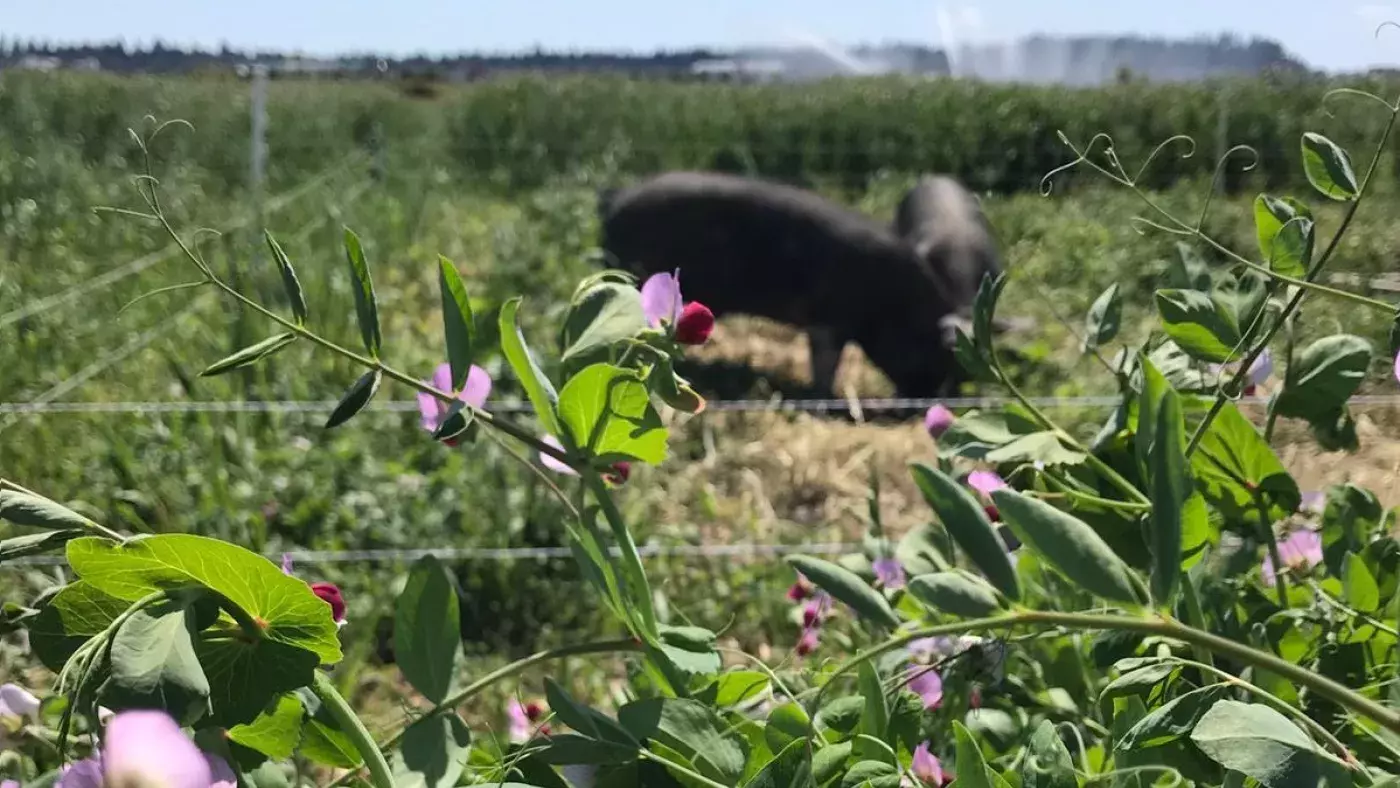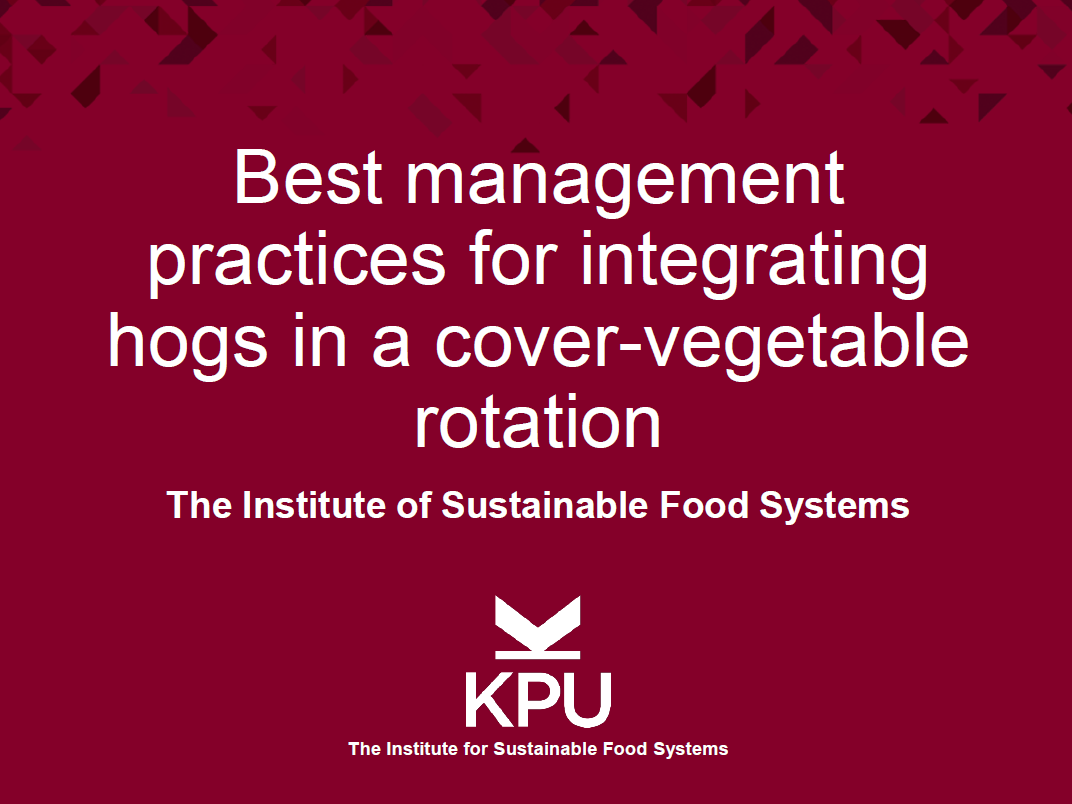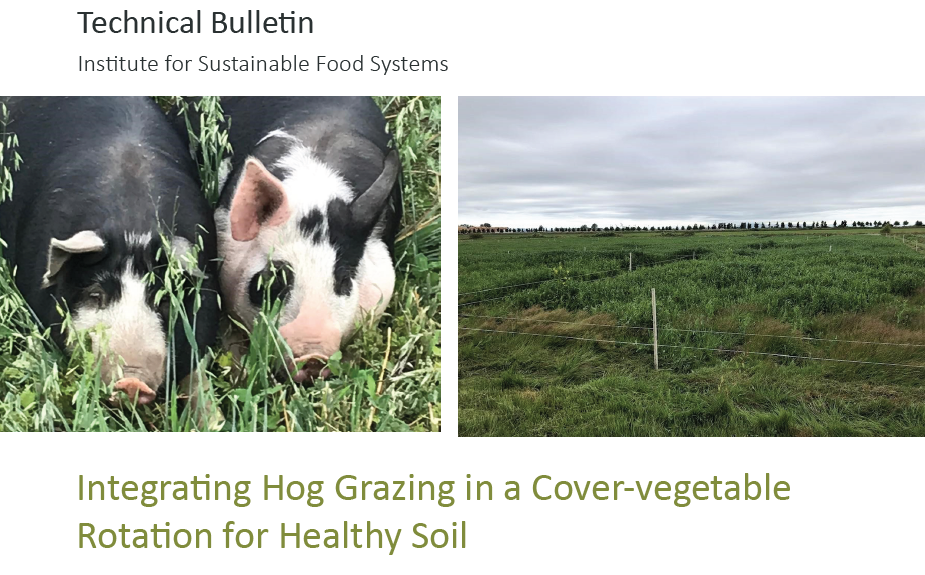

Integrating hogs in a cover-vegetable rotation for healthy soils and humans
What is the project about?
ISFS is in the midst of an exciting production research project entitled “Integrating hogs in a cover-vegetable rotation for healthy soils & humans “This effort began in the spring of 2018 and we are several years into the study. The main thrust of this project is to determine the potential benefits for small scale farmers from integration of hog and vegetable production. Most market crop farmers routinely put part of their total growing acreage into cover crops for a season, as part of their crop rotation plan. A common management practice is to sow, grow and turn under the cover crop in these "resting" fields up to 3 times per year (spring, summer and fall). This practice is aimed at adding soil organic matter (SOM), enhancing fertility and controlling weeds and diseases. However, the practice of tilling these cover crops back into the soil to terminate growth also negatively impacts soil structure and biological activity while contributing to soil compaction, generating greenhouse gas emissions and increasing the potential for soil erosion. These effects are exacerbated in clay textured soils such as those present in the Fraser Delta in British Columbia. Additionally, this management method requires machinery and implements not necessarily available to smaller scale and start up market crop farmers, many of whom we at ISFS work to support.
Years of informal experimentation on our teaching and research farm, as well as from numerous exchanges with farmers actively practicing Integrated Crop Livestock Systems farming (ICLS) has convinced us of the merits of using hogs as part of a sustainable crop rotation, nutrient cycling and land management system for market crop farming. When managed well, an integrated hog and crop system can reduce labour and revitalize neglected and diminished fields rapidly, getting them into a productive state while eliminating the need for expensive machinery, hence making this a particularly viable option for new entrant and smaller scale farmers. This, through the integration of hog grazing to terminate cover crops, this research seeks to find regenerative ways to manage cover crops and on-farm fertility while reducing reliance on the extensive use of tractor tillage has important environmental and climate change ramifications, small scale farm start-up and ongoing economic implications.
Project Objectives
This research, being conducted at the Tsawwassen First Nation Farm School, located on Tsawwassen First Nation land, has several objectives.
- To investigate the impacts of integrating hog strip grazing in a market vegetable –cover crop rotation system on soil quality, the nutrient life cycle from soil to plants, subsequent vegetable harvest and the economics of such integration
- To compare cover cropping system managed with hogs to a system managed with tractor tillage.
- To use Randomized Complete Block Design to set up the experimental field using pigs in a strip grazing system and a tractor tillage system to seed and then manage cover crops.
- To use standard agronomic practices to manage cover crops and their impacts on soil, cover crop development, hog growth and crop nutrition will be analyzed and compared.
This research lies at the interface between applied scientific investigation and technical knowledge generation. It is also novel as it attempts to bridge segregated domains of agriculture, environmental health and climate change, indigenous food sovereignty, soil science, food systems, and human health and nutrition under one holistic approach.
Research Team
Lead Research Team
Leah Sandler, PhD - Organic Agriculture Research Associate
Email: leah.sandler@kpu.ca
Micheal Robinson, Research Associate
Email: micheal.robinson@kpu.ca
Dr. Kent Mullinix, ISFS Director, Principal Investigator
Email: kent.mullinix@kpu.ca
Research Affiliates
Dr. Sean Smuckler, Assistant Professor, Faculty of Land and Food Systems, University of British Columbia
Corine Singfield, Former Masters student and lead researcher
Industry Partners and Collaborators
- Naut'sa mawt Tribal Council: AAFC funding recipient
- University of British Columbia
- West Coast Seed
- Coast Capital Savings
Funder
This project is funded in part by the Government of Canada under the Canadian Agricultural Partnership's AgriScience Program, a federal, provincial, territorial initiative.
Research Updates
December 2019
The first season of field research has come to a close. Following intensive soil sampling in the spring a cover crop was established and the hogs were moved into their grazing plots. They moved through without issue and the incorporation of cover crop into the grazing units worked flawlessly. After the first rotation the summer cover crop was established, and hogs began working their way back through the plots. In September, the fall cover crop was spread in the tilled plots and in the grazing plots following behind the hogs as they moved through the plots for a second time.
September 26, 2019 - The hogs finished their final rotation and were removed from the research plots.
We have a successful cover crop stant of fall rye and vetch moving into winter, that is currently overwintering. It has served as good forage for the migrating geese moving through the area. Soil sampling will commence on all plots in the spring when water content of the soil has reduced. Field edges were left marked to facilitate vegetable trials next year.
In our research vegetable field (the hog field in 2018), poor germination and a weed infestation led to minimal chances for useful sampling. Due to uneven treatments being applied, we wrote off attempting a second crop. Corn and carrots were harvested for sale by the TFN Farm School after the plots were deemed not useful for data collection. The fields were returned to cover crop after the experiment ended.
August 2020
This summer is the second year of grazing hogs at the TFN Farm School. This spring we seeded a pasture into summer spring cover (peas, clover and oats) and the pigs are now happliy in their research plots. We move them to the next plot approximately every week. Pigs are moved when most of the cover crop had been uprooted and laid on the ground but before hogs could begin cratering. Best management practices are to move hogs when no more than 20% round was visible or devoid of cover. This usually corresponded with 5-12 days depending on cover crop growth stage, weather and soil moistures.
July 27, 2020 - We mowed and tilled those plots that are receiving the conventional tillage treatment and planted the summer cover.
The field that was in pasture last year (for pigs and tillage treatment) was planted in corn and winter squash this spring, following rigorous soil sampling from all plots for physical attributes included aggregate stability, bulk density, penetration resistance, volumetric water content and texture; chemical attributes included nitrate and ammonium and electrical conductivity, and; biological attributes included active carbon and soil respiration. The corn is now in growth stage v8 and is about 4.5 ft tall.
December 2020
The second season of field research has come to a close. In September, the fall cover crop was spread in the tilled plots and in the grazing plots following behind the hogs as they moved through the plots for a second time. Once the hogs had been moved through all the grazing plots, they were taken off of the research fields and returned to the main herd. The movable houses and barrel waters were removed with the electri fencing, however, all posts remained in the ground to ensure accurate sampling for next season's vegetable crops. We have a successful cover crop stand moving into winter, that is currently overwintering. It has served as good forage for the migrating geese moving though the area. Soil sampling will commence on all plots in the spring, when water content of the soil has reduced.
August 31, 2020 - Broadcase fall cover crop of fall rye and vetch into tilllage plots
September 24, 2020 - Hogs removed from research field after reaching final grazing plot.
In our research vegetable field (2019's hog field), sweet corn was harvested every few days, ears reached maturity, from September 5th to September 29th. For research purposes, representative samples were harvested on September 25th: stand count, ear number and weight were taken. Differences across plots were observed and data is being analyzed to determine if statistical differences exist among treatments. Yields ranged from 9 to 18 kg m/6 row. We has a very successful butternut squash stand. Butternut squash were harvested on September 30th and entire plots were weighed, separating marketable yield from unmarketable yield. We had a yield of 6,500 lbs of squash, with differences across plots. Yields are being analyzed to determine if statistical differences exist among treatments.
April - June 2021
In our last field season for the hog integration project we saw good success in our vegetable field even through difficult growing conditions. Our research field this year, weas where the hogs were grazed last year and, in following with the research protocol we planned to plant butternut squash and sweet corn in each treatment plot (hog grazing and conventional tillage). In April, as we took soil metrics and measurements, our water moisture and electrical conductivity probe broke. This was important data to collect before prepping the field for vegetables so we were slightly delayed in getting into our field with tillage as we waited for the piece to be repaired. This meant that on May 17th, we were able to chisel and disc the field, wait for breakdown of residue and then spread compost and disc it in. Planting of corn (Jang seeder) and squash (hand seeded) happened on June 7th, a little later than anticipated.
July - October 2021
As many of you in BC are aware, this summer was unusually hot and dry. In Tsawwassen we saw no rain for several months after the middle of June, and this meant with seeds just in the ground and early growing stages plants were stunted in their growth. We saw good germination and emergence in both the squash and the corn, but we needed to irrigate via overhead water wheel irrigation from planting all the way through later staged of corn development (tasseling) in late August. Weed emergence was taken from all plots, and then subsequently weeded throughout the season. We has high weed pressure in the corn plots and some of this could have been due to the later termination of cover crop and spring annual weeds due to the delay in tillage while waiting for the probe to be repaired.
Because plants were slow growing due to extreme heat and dryness, we applied foliar BioFert fish fertilizer (2.8% N) on July 22nd, in order to give a nutrient boost to plants. We were concerned about plants reaching maturity in a timely manner, before fall brought colder temperatures and rain, and the fertilizer was to give it a quick boost to speed up growth. Corn reached tasseling at the end of August and ear development continued into September. A very strong wind storm at the beginning of September, accompanied by rain ended up blowing the majority of the corn field down. WE believe this was due to high winds (common in Tsawwassen) as well as an influx in water that the soil hadn’t seen all season and softened the ground considerably. Luckily the plants were not broken just blown over and ears were able to continue to mature. Blown down plants did delay harvest somewhat, and harvest for data measurements occurred on October 6. As for the squash, it was not impacted by the storm and the butternuts matured on the vine and were harvested on September 29th on a very wet day. Due to the slow growth season, some squash were a bit green (could have done with a week or two more on the vine), but with the influx of precipitation this fall, we needed to get the squash out of the field so that it wouldn’t rot. Both crops saw decent yields, and now that we have harvested, data is being collected and analyzed.
Nov - Dec 2021
We are excited to be working on data reports and extension documents this winter to present all of the results of these three years of research and develop documents that outline all of the techniques we used and learned.
May 2022

The Best Management Practices (BMP) report is

Research findings are summarized in a
Videos
Hogs vs Machine - Advancing BC's Farming and Food Sector, KPU's Instute for Sustainable Food Systems (Video created by the KPU Office of Research Services)
Moving hogs to a new rotational grazing plot
Small Scale Meat Producers Association's webinar recording on our research project
PPT presentation slides - Canadian Weed Science Society Annual Meeting
Don't forget to subscribe to the ISFS YouTube channel to stay up to date with all our research activities!